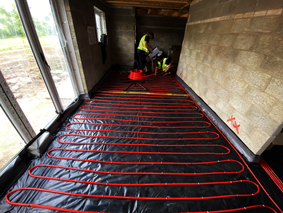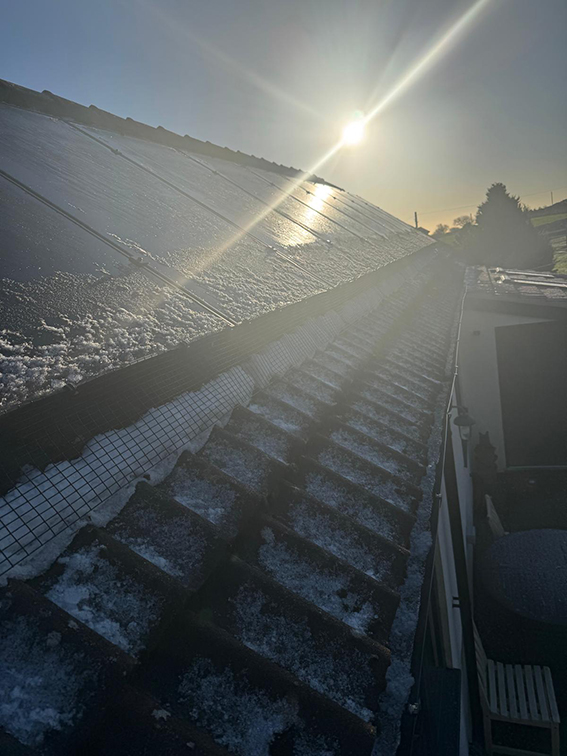
Heat Pumps and Underfloor Heating: A Perfect Match?
How Heat Pumps Work: The Basics You Need to Know
We have a full blog on this here – so if you want a more in depth explanation of the way a heat pump works just give it a click.
Meanwhile here is a simple explanation:
Heat is drawn from an external source, like a body of water, the ground or the air, and used to slightly raise the temperature of a refrigerant in pipes.
That refrigerant is then put under intense pressure, raising the temperature considerably.
Once at a suitable temperature the now hot pipes are used to heat water for your central heating.
But, heat pumps don’t work like traditional combi-boilers as they aren’t instant.
You can’t come into a room feel chilly then whack the heat pump on to warm your hands on a radiator.
Nope, heat pumps work by keeping the property at a constant temperature.
This means they are much more efficient than combi boilers, but it also means you have to make sure you utilise their energy efficiently.
Why Underfloor Heating Pairs So Well with Heat Pumps
That whole ‘keep the house at an even temperature’ thing is why heat pumps work really well with underfloor heating.
Radiators are great at heating rooms up quickly and keeping them warm – but the minute the radiator goes off the heat starts to dissipate very quickly.
Underfloor heating doesn’t just heat the air in the room, it also heats the floor!
So, you can imagine that the whole floor is like a giant radiator but were underfloor heating differs is that the heat is captured and released more slowly.
Even after the hot water stops flowing through the pipes, the material surrounds them, and the carpet/flooring above them will retain the heat for a good while.
That means the rooms will stay warm longer and the heat pump will work in a much more efficient manner.
Energy Efficiency Benefits of Combining Both Systems
Underfloor heating requires a much-reduced water temperature when compared to radiators.
As heat pumps are at their most efficient when working at lower temperatures, this means UFH is the perfect match.
Under floor heating works over a large surface area, so it distributes small amounts of heat all over the room.
This creates a very efficient heating system using small amounts of energy, reducing both bills and carbon footprints.
Comparing Underfloor Heating to Radiators for Heat Pump Use
Now, don’t get us wrong here, heat pumps work perfectly well with radiators so you don’t need to throw the baby out with the bath water and demand UFH in every room.
You may need to replace a few of your current radiators to get the best out a heat pump though.
It's a good thing too, as it means we are starting to think more about how we heat our homes, how we can utilise our energy and what we need to do to reduce waste.
In comparison, if you spec your radiators correctly then they will perform very well for the rooms they are in.
However, an underfloor system will always be the best way to heat your home.
Types of Heat Pumps Suitable for Underfloor Heating
All three types of heat pumps are suitable with underfloor heating as they all work in basically the same way, and they all work at lower temperatures.
What are the 3 types of pump?
Ground Source – pipes are laid either vertically or horizontally in the ground and the natural temperature of the soil heats the refrigerant.
Water Source – the same as ground source but the pipes are laid in a river, lake or large pond.
Air source – the most common type of heat pump for domestic installations. A large fan draws air into the pump unit and heats the refrigerant that way.
Installation Considerations for an Integrated System
You can retrofit heat pumps to most domestic homes without having to fit underfloor heating – you just need to make sure your radiators are suitable.
If you are building a new home, or doing a top to bottom renovation, then it’s worth considering installing underfloor heating and a heat pump.
Retro-fitting UFH is possible, but it can require the floor being removed to make way for the pipes and insulation.
There are systems that don’t require digging up the floor too.
These require specially made tiles to plaid on top of your existing floor.
The pipes are run through grooves in those tiles and the whole shebang is topped of with more tiles to hide the pipes.
Of course, that means your floor is about 10 mm higher than it was to start with, but that just means you have to take a little bit off the bottom of your doors … which is much less hassle than digging the front room floor up.
Running Costs: What Homeowners Can Expect
Providing that you have a correctly set up heat pump installation, with the correct heat loss calculations and the best heat pump, you will save a little money on your heating.
Heat pumps are, on average, 300% more efficient than a traditional gas combi boiler.
But, as gas is 3 times cheaper than electricity, the running cost tend to work out very similar.
However, if you have replaced electric heating methods with a heat pump, then you will reduce your heating cost considerably.
Is This the Right Heating Solution for Your Home?
That is not a question we can’t answer in a blog, we’d have to visit your home and do a full survey.
If anyone claims they can just tip up and install a pump, avoid them!
If a system is being fitted to an already built property, then insulation levels need to be looked at, heat loss calculations need to be done, and measurements need to be taken.
A surveyor will also look at your current radiators to see if anything needs replacing or swapping to different rooms.
If you are involved in a major renovation of a property, or are starting a new build from scratch, then we’d say a heat pump, in conjunction with underfloor heating, is the perfect and greenest way to heat your home.


